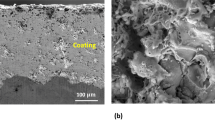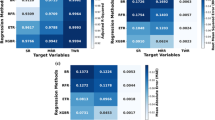Abstract
Thin sheets of titanium alloys are widely used in aerospace and automotive industries for specific applications. The creation of micro holes with requisite hole quality in thin sheets of these alloys using energy of electric discharge is a challenging task for manufacturing engineers. Hole sinking electrical discharge micromachining (HS-EDMM) is one of the most promising micromachining processes to create symmetrical and non-symmetrical micro holes. The present paper is related to selection of optimum parameter settings for obtaining maximum material removal, minimum tool wear and minimum hole taper in HS-EDMM. In this paper an attempt has been made to develop an integrated model (ANN-GRA-PCA) of single hidden layer back propagation neural network (BPNN) for prediction and grey relational analysis (GRA) coupled with principal component analysis (PCA) hybrid optimization strategy with multiple responses of HSEDMM of Ti-6Al-4V. Experiments have been conducted to generate dataset for training and testing of the network where input parameters consist of gap voltage, capacitance of capacitor and the resulting performance parameters are represented by material removal rate (MRR), tool wear rate (TWR), and hole taper (Ta). The results indicate that the integrated model is capable to predict and optimize process performance with reasonable accuracy under varied operating conditions of HS-EDMM. The proposed approach would be extendable to other configurations of EDMM processes for different materials.
Similar content being viewed by others
References
V. K. Jain, Introduction to micromachining, Narosa Publication House Pvt. Ltd., India (2010).
Y. S. Wong, M. Rahman, H. S. Lim, H. Han and N. Ravi, Investigation of micro-EDM material removal characteristics using single RC-pulse discharges, Journal of Materials Processing Technology, 140(1–3) (2003) 303–307.
Z. Wansheng, Y. Yang, W. Zhenlong and Z. Yong, A CAD/CAM system for micro-ED-milling of small 3D freeform cavity, Journal of Materials Processing Technology, 149(1–3) (2004) 573–578.
I. Yoshihito, N. Takayuki, M. Hidetaka, H. Hirofumi and T. Hitoshi, Local actuator module for highly accurate micro-EDM, Journal of Materials Processing Technology, 149(1–3) (2004) 328–333.
H. Fuzhu, S. Wachi and M. Kunieda, Improvement of machining characteristics of micro-EDM using transistor type isopulse generator and servo feed control, Journal of Precision Engineering, 28(4) (2004) 378–385.
H. S. Liu, B. H. Yan, F. Y. Huang and K. H. Qiu, A study on the characterization of high nickel alloy micro-holes using micro-EDM and their applications, Journal of Material Processing Technology, 169(3) (2005) 418–426.
S. Son, H. Lim, A. S. Kumar and M. Rahman, Influences of pulsed power condition on the machining properties in micro EDM, Journal of Materials Processing Technology, 190(1–3) (2007) 73–76.
M. P. Jahan, Y. S. Wong and M. Rahman, A study on the fine-finish die-sinking micro-EDM of tungsten carbide using different electrode materials, Journal of Materials Processing Technology, 209(8) (2009) 3956–3967.
E. Uhlmann, S. Piltz and U. Doll, Machining of micro/miniature dies and moulds by electrical discharge machining- Recent developments, Journal of Materials Processing Technology, 167(1) (2005) 488–499.
Y. S. Tarng, S. C. Ma and L. K. Chung, Determination of optimal cutting parameters in wire electric discharge machining, International Journal of Machine Tools and Manufacture, 43(6) (1995) 995–999.
E. O. Ezugwu, D. A. Fadare, J. Bonney, R. B. Da Silva and W. F. Sales, Modelling the correlation between cutting and process parameters in high-speed machining of Inconel 718 alloy using an artificial neural network, International Journal of Machine Tools and Manufacture, 45(6–7) (2005) 1375–1385.
P. Allen and X. Chen, Process simulation of micro electrodischarge machining on molybdenum, Journal of Materials Processing Technology, 186(1) (2007) 346–355.
G. Indurkhya and K. P. Rajurkar, Artificial neural network approach in modeling of EDM process, Proc. Artificial neural networks in engineering, St. Louis, Missouri, USA (1992) 845–850.
A. P. Markopoulos, D. E. Manolakos and N. M. Vaxevanidis, Artificial neural network models for the prediction of surface roughness in EDM, Journal of Intelligent Manufacturing, 19(1) (2008) 283–292.
K. P. Somashekhar, J. Mathew and N. Ramachandran, Multi-objective optimization of micro wire electric discharge machining parameters using grey relational analysis with Taguchi method, Proc. IMechE Part C: Journal of Mechanical Engineering Science, 225(7–8) (2010) 1742–1753.
K. Wang, H. L. Gelgele, Y. Wang, Q. Yuan and M. Fang, A hybrid intelligent method for modelling the EDM process, International Journal of Machine Tools and Manufacture, 43(10) (2003) 995–999.
Y. Y. Yang, J. R. Shie and C. H. Huang, Optimization of dry machining parameters for high purity graphite in endmilling process, International Journal of Material Manufacturing Process and Technology, 209(3) (2006) 832–837.
Author information
Authors and Affiliations
Corresponding author
Additional information
Recommended by Associate Editor In-Ha Sung
Rajesh Kumar Porwal received his B.E. and M.E. from SVNIT Surat, and BIT, Mesra, Ranchi, India, in 1998 and 2003, respectively. He is currently pursuing his Ph.D. in the Department of Mechanical Engineering, MNNIT, Allahabad, India. He is having eleven years of teaching and three years of industry experience. His research interests include advanced manufacturing processes, design of experiments and application of soft computing techniques in manufacturing.
Rights and permissions
About this article
Cite this article
Porwal, R.K., Yadava, V. & Ramkumar, J. Modelling and multi-response optimization of hole sinking electrical discharge micromachining of titanium alloy thin sheet. J Mech Sci Technol 28, 653–661 (2014). https://doi.org/10.1007/s12206-013-1129-0
Received:
Revised:
Accepted:
Published:
Issue Date:
DOI: https://doi.org/10.1007/s12206-013-1129-0




